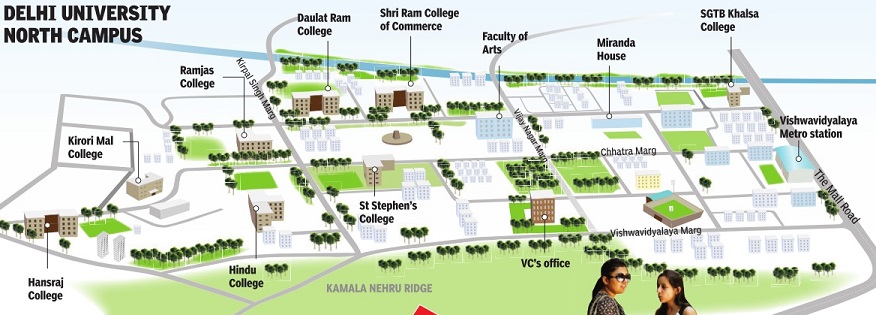Delhi University campus: maps, graphs, facts
This is a collection of articles archived for the excellence of their
content. You can update or correct this page, and/ or send graphs to the Facebook page, Indpaedia.com. All information used will be duly acknowledged. |
Contents |
Delhi University: maps, graphs, some basic facts










Cut-off marks



Canteens, cafés, dhabas
2016
The Times of India, Jun 27, 2016
Samir Devnani
Outside the classrooms, Delhi University's many canteens, tea stalls and chhola-kulcha stands provide a space where students can bond over a variety of pocketfriendly food items. Attracting a large number of `outsiders' are Panditji's at Gwyer Hall and Anna's at PG Men's Hostel. Anna's canteen still attracts alumni by the dozens. Manish Chauhan, who graduated from SGTB Khalsa College in 2009, still hangs out with his friends here. They get together nearly every evening at the canteen sharing a communal smoke, dosas and kathi rolls. The vegetarian kathi roll and masala dosa here still come for Rs 30 a plate; paneer dosa is for Rs 40.
Nirpendar Kumar, who graduated from Hindu College in 2014, eats only at DU canteens. “My seniors took me and my classmates to Anna's first,“ said Kumar, who subsequently initiated his juniors and still returns for veg pulao every now and then.
Deepu's tea stall on the DSE premises was established in 1970 and is still going strong. Visitors enjoy the student-friendly credit system the stall has instituted.
Some college canteens are similarly famous despite restricted entries. The Shri Ram College of Commerce has a bustling canteen which caters to about seven major colleges, but all are not affiliated to DU. Kumar Sanjay Singh of Aradhya Caterers believes that if colleges relax the access for canteens, it'll be better for business.
South Campus lies close to dozens of private cafeterias and restaurants, but also has a canteen in the premises.Another popular eatery for lovers of South Indian food is at Sri Venkateswara College.
English proficiency courses
The Times of India, Jun 07 2016
While study material in Hindi is still scarce for most subjects in Delhi University, there's help available with English. Several colleges run English proficiency courses, free or self-financed, to help students who struggle with the language. Indraprastha College for Women launched an English course as a part of its “Diversity Integration Programme“ last year. The 40session course ends in a certificate for those with at least 85% attendance. The modules were designed and originally delivered by a retired teacher from the English department of the college. “We have students from different backgrounds and the average student's English communication and language skills are very poor. But proficiency in English is important for accessing further levels of higher education and also employment,“ says principal Babli Moitra Saraf.
The course is free, has already run for two semesters and is meant primarily for final-year students. It runs a computer literacy programme as well. Several colleges run the English Language Proficiency Course, a largely self-financed programme that was originally designed by teachers from the Institute of Lifelong Learning and Department of Education. It is a standard 80-hour curriculum, delivered over three months, and has been popular despite running into patches of funding trouble.
Manoj Garg, convenor for the classes at Acharya Narendra Dev College, which is primarily a science-teaching institution, says that they get as many as 100-120 applications for a 35-seat batch that includes a test after 76 hours.
Add-on courses
The Times of India, Jun 11 2016
Delhi University colleges aren't just good for bachelor's courses. Many of them also run short-term “add-on“ courses. These are either certificate courses in foreign languages or specialised courses and undergraduate research programmes. The college running a co urse may even choose to allow students from other institutions to attend. Gargi College's courses on advertising and banking and financial services, for instance, are also open to students attending other colleges. “These are eight-month courses and roughly 50% of the class is from outside,“ says principal Shashi Tyagi.
The college also runs a German language course for students from within the college and, Tyagi adds, they may launch science courses on research methodology , biotechnology and green-chemistry . “For some of shorter, certificate courses, we don't charge at all. But for the longer, professional ones--such as the commerce courses--we do charge because we have many applicants from outside and hence, have to conduct exams as well. These are all very popular.“ Some of the science courses will be funded by grants from the Department of Biotechnology . Indraprastha College for Women has two newlylaunched centres--Centre for Earth Studies and Centre for Interdisciplinary Studies--that will run undergraduate research programmes among students enrolled in the college. Kamala Nehru College (KNC) runs a three-level certificate course in French that's self-financed but run in collaboration with DU's Department of Germanic and Romance Studies. It also has an add-on course on environment and eco-tourism which, says KNC spokersperson, Geetesh Nirban, is “majorly sponsored“ by Delhi government's department of environment.
Lady Shri Ram College has offered a Spanish course, levels one and two, for over five years. They also run shortterm courses on mathematical modelling and film appreciation. Typically , each batch has about 40-50 students. But in 2015, the college had offered a course on women and law that had 70. That programme was open to students from other colleges as well. The psychology department of the college is now in the process of designing a course on “peace psychology“. “Every year we put up a list and ask people if they would be interested in the courses. They are very popular,“ says teacher Rukshana Shroff.
Ramjas College's website lists over 20 short-term programmes including ones on “peace and conflict resolution“, “India in the era of globalisation“, “human rights studies“, “environmental management and law“, “film appreciation“, “mass media ethics studies“ and “development of entrepreneurship excellence“ and “Gandhigiri -reinterpreting Gandhi in modern context.“
Hansraj College offers “job-oriented“ courses including “radio-jockeying, anchoring and TV journalism“, “acting and film-making“ and “mass communication, journalism and marketing“, which are run in partnership with private firms.
"Quality status": NAAC, college-wise: 2016
SRCC, LSR lead UGC body's scores for DU, Dec 28, 2016: The Times of India

More than 30 Delhi University colleges have received the now-mandatory scores on their `quality status' from the National Accreditation and Assessment Council, and the results have mauled quite a few institutional reputations. St Stephen's, among the best known colleges in DU, is 12th in the list and Sri Venkateswara, another reputed institution, is ranked 14th. Shri Ram College of Comerce has received the hig merce has received the highest score of 3.65 among the 35 colleges evaluated.
It's followed closely by Lady Shri Ram College for Women with a 3.61 score. St Stephen's College was en a score of 3.21, below given a score of 3.21, below colleges such as Hindu, Kirori Mal, Khalsa, IP, Gargi, Jesus and Mary and Acharya Narendra Dev.
NAAC, an autonomous body of UGC, gives out accreditation status based on a college's performance in parameters such as covering the curriculum, teaching-learning, evaluation, faculty , research, infrastructure, learning resources, governance and student services.
In 2012, University Grants Commission, the higher education funding agency , began the process of making NAAC accreditation mandatory for colleges. DU accepted it in 2014 and this is the first year when so many colleges have received NAAC scores.
While the accreditation process got a thumbs up from some colleges, many have raised objections over the assessment criteria. Babli Saraf, principal of Indraprastha College for Women, said there shouldn't be a “one-size-fitsall“ criteria for colleges. “The criteria shouldn't be the same for a liberal arts college like ours, where we do not have the provisions for a laboratory and are not involved in research publications,“ she said.
A few colleges expressed satisfaction over the process.Said Dinesh Khattar, principal of Kirori Mal college, “We faced several academic and financial difficulties in the past one-and-a-half years, but managed to revamp the college structure. The NAAC, which visited us for three days in October, interacted with all stakeholders -teachers, non-teaching staff, students and even parents -to get a complete picture. The college got the fourthhighest score in the university .
Many said the evaluation system needed to be rationalised. Anuja Srivastava, princi pal of Hindu College, said NAAC should consider other aspects. “They should also review the college's reputation and extension aspects. Extracurricular activities should get extra weightage,“ she said.
Shashi Tyagi, principal of Gargi College, which was positioned 10 with 3.30 points, attributed the high CGPA score to the holistic approach that the college takes towards students.
“The good score is the result of consistent hard work over 10-15 years. We take care of all our students, while they are with us and much later too.And that's true for speciallyabled students or those from weaker sections,“ she said.
Other colleges such Zakir Husain (3.12), Deshbandhu (2.80), PGDAV (2.74), Motilal Nehru College (2.60) and Deen Dayal Upadhyaya College (2.63) also figured in the list.
Among affiliated colleges, the maximum weightage has been given to teaching and learning aspect. The evaluation was made out of 4 points.

